| Eco Bites |
 |
|
Emergent Weeds in the Table Bay Nature
Reserve |
 |
|
There are several species of weeds that
occur in large numbers in our
conservation areas and also in public
open spaces and along our roadsides.
These are most visible this time of the
year as they all flower between August
and October. |
|
Residents are encouraged to remove these
weeds from their gardens should they
occur there. All are invasive and can
spread rapidly. The seven species we are
most concerned about, are the following: |
 |
|
Echium plantagineum (Patterson’s
Curse) |
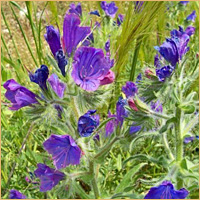 |
|
Echium plantagineum, commonly
known as Patterson's Curse, is native to
western and southern Europe (from
southern England south to Iberia and
east to the Crimea), northern Africa,
and southwestern Asia. |
|
It has been introduced to Australia,
South Africa and United States and is an
invasive plant. Due to a high
concentration of pyrrolizidine alkaloids
in the shoot it is poisonous to grazing
livestock, especially those with a
simple digestive system like horses. The
toxins are cumulative in the liver and
death results from too much Paterson's
curse in the diet. |
|
Echium plantagineum is a winter
annual plant growing to 20–60 cm tall,
with rough, hairy, lanceolate leaves up
to 14 cm long. The flowers are purple,
15–20 mm long, with all the stamens
protruding, and borne on a branched
spike. |
|
Echium plantagineum is a
Category 1 Declared Weed in terms of the
Conservation of Agricultural Resources
Act, Act 43 of 1983, and must be removed
by landowners. |
 |
|
Argemone mexicana (Mexican poppy) |
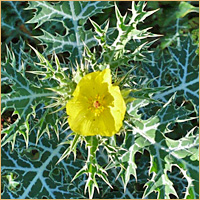 |
|
Argemone mexicana (Mexican
poppy or Mexican prickly poppy) is a
species of poppy found in Mexico and now
widely naturalized in the United States,
India and Ethiopia. |
|
The plant has also spread to many other
countries where it is considered a
nuisance as it |
|
The seeds resemble the seeds of
Brassica nigra (mustard). As a
result, mustard can be adulterated by
argemone seeds, rendering it poisonous.
Several significant instances of
poisoning have been reported in India,
Fiji, South Africa and other countries.
1% adulteration of mustard oil by
argemone oil has been shown to cause
clinical disease. |
|
|
 |
|
Lavatera arborea (Tree Mallow) |
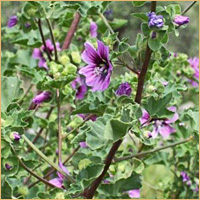 |
|
Lavatera arborea or Malva
arborea, the Tree Mallow, is a
species of mallow native to the coasts
of western Europe and the Mediterranean
region, from the British Isles south to
Algeria and Libya, and east to Greece. |
|
Lavatera arborea tolerates sea
water to varying degrees, at up to 100%
sea water in its natural habitat,
excreting salt through glands on its
leaves. This salt tolerance can be a
competitive advantage over inland plant
species in coastal areas. |
|
Tree Mallow seeds may be transported
between separated coastal areas by the
floating fruit, and seabirds are
considered a likely means of spread. The
seeds are encased in an impermeable
outer case, and can remain viable for
years, even after extended immersion in
saltwater. |
|
The Tree Mallow's recent increased range
in many countries has raised concerns
that it is displacing native vegetation.
Its spread among Australian islands in
recent decades is thought to be reducing
biodiversity, soil retention, and
seabird habitat. |
 |
|
Rapistrum rugosum (Wild mustard) |
 |
|
Rapistrum rugosum is a species
of flowering plant in the mustard family
known in South Africa as Wild Mustard.
It is native to Eurasia and parts of
Africa, and it is present throughout the
world as an introduced species and a
common weed. It is an invasive species
in many areas. |
|
In South wild mustard is a major problem
in grain-growing areas as it adulterates
the seeds of the grains during
harvesting, lowering the standard of
grain flour |
|
|
|
|
|
|
 |
|
Lupinus luteus (Lupins) |
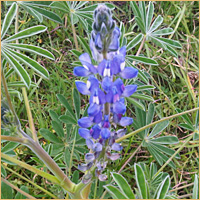 |
|
Lupinus, commonly known as
Lupins or lupines, is a genus in the
legume family (Fabaceae). The genus
comprises about 280 species, with major
centers of diversity in South and
western North America, and the Andes and
secondary centers in the Mediterranean
region and Africa. |
|
Given that lupin seeds have the full
range of essential amino acids and that
they, contrary to soy, can be grown in
more temperate to cool climates, lupins
are becoming increasingly recognized as
a cash crop alternative to soy. Three
Mediterranean species of lupin, Blue
Lupin, White Lupin, and Yellow Lupin are
widely cultivated for livestock and
poultry feed. |
|
Lupins are popular ornamental plants in
gardens. There are numerous hybrids and
cultivars. Some species, such as Garden
Lupin (Lupinus polyphyllus) and
hybrids like the Rainbow Lupin (L. ×
regalis) are common garden flowers.
Others, such as the Yellow Bush Lupin (L.
arboreus) are considered invasive
weeds when they appear outside their
native range. |
 |
|
Vicia benghalensis (reddish tufted
vetch) |
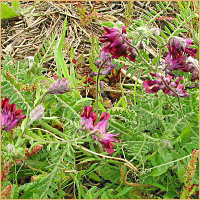 |
|
Vicia benghalensis is a species
of vetch known by the common names
purple vetch and reddish tufted vetch.
It is native to southern Europe, North
Africa, and nearby islands, and it is
utilized elsewhere in agriculture and
may be present in the wild as an
introduced species. It is an annual herb
with a climbing stem which is coated in
hairs, often densely, making the plant
appear silvery white. |
|
This plant is used as a cover crop and
green manure for the purposes of soil
improvement and weed and pest control.
It is used in crop rotation, for hay and
fodder, and as a honey plant, and it has
a very high biomass yield. |
|
The vetches grown as forage are
generally toxic to non-ruminants (such
as humans), at least if eaten in
quantity. Cattle and horses have been
poisoned by Vicia villosa and
Vicia benghalensis, two species
that contain canavanine in their seeds. |
 |
|
Euphorbia helioscopia (Umbrella
milkweed) |
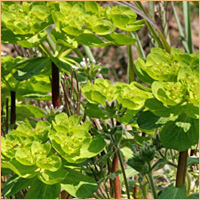 |
|
Euphorbia is a genus of plants
with over 2000 species, it is one of the
most diverse genera in the plant
kingdom, exceeded possibly only by
Senecio. Members of the family and
genus are known as milkweeds due to the
milky sap exuded by the plant when
damaged. The genus is primarily found in
the tropical and subtropical regions of
Africa and the Americas, but also in
temperate zones worldwide. Succulent
species originate mostly from Africa,
the Americas and Madagascar. |
|
The latex (milky sap) acts as a
deterrent for herbivores as well as a
wound healer. As it is under pressure,
it runs out from the slightest wound and
congeals within a few minutes of contact
with the air. In contact with mucous
membranes (eyes, nose, mouth) the latex
can produce extremely painful
inflammation. Euphorbias should thus be
handled with caution. |
 |